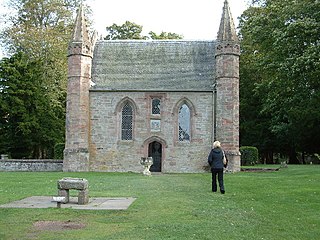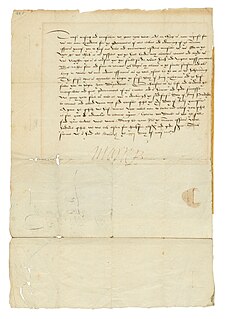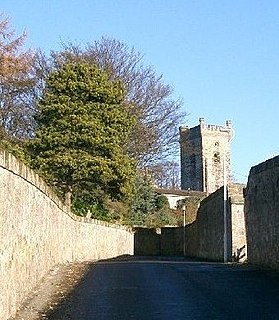See also
Senior churchmen of Medieval Scotland (post-1100) | |
|---|---|
| Archbishops | |
| Bishops | |
| Archdeacons | |
| Abbots | |
| Priors | |
| Settlements | ||
|---|---|---|
| Administration |
| |
| Culture | ||
| Geography | ||
| History | ||
| Sport | ||
| Transport |
| |
The Abbot of Crossraguel was the leader of the Cluniac monastic community of Crossraguel Abbey, near Maybole in Carrick, south-west Scotland. It was founded in 1260s by Donnchadh mac Gille Brigte, earl of Carrick with monks from Paisley Abbey. Owing to the lack of surviving records and its distance from the core of Lowland Scotland in the western Gàidhealtachd, few of the abbots are known by name. The abbots were replaced by commendators in the 16th century, and the abbey came to an end when its lands were taken over by the bishops of Dunblane in 1617.
The royal warrant in 1886 which revived the office of Dean of the Chapel Royal also gave the Dean the titles of Abbot of Crossraguel and Abbot of Dundrennan. [1]
The following is a list of abbots and commendators:
The dissolution of monasteries then caused a cessation of true abbots in the functional sense.

Dunure Castle is located on the west coast of Scotland, in South Ayrshire, about five miles south of Ayr and close to the village of Dunure. Today the castle stands in ruins on a rocky promontory on the Carrick coast, overlooking the small harbour of Dunure.

Paisley Abbey is a parish church of the Church of Scotland on the east bank of the White Cart Water in the centre of the town of Paisley, Renfrewshire, about 7 miles west of Glasgow, in Scotland. Its origins date from the 12th century, based on a former Cluniac monastery. Following the Reformation in the 16th century, it became a Church of Scotland parish kirk.

The Abbey of Saint Mary of Crossraguel is a ruin of a former abbey near the town of Maybole, South Ayrshire, Scotland. Although it is a ruin, visitors can still see the original monks’ church, their cloister and their dovecot.
The Abbot of Paisley was the head of the Cluniac monastic community of Paisley Abbey and its property. The monastery was founded as a priory at Renfrew in 1163, but moved to Paisley in 1169. It became an abbey in 1219. The founder was Walter fitz Alan, Seneschal (Steward) of Scotland. The line of abbots ended when it was turned into a secular lordship for Lord Claud Hamilton in 1587/1592. The following is a list of abbots and commendators:

Glenluce Abbey, near to Glenluce, Scotland, was a Cistercian monastery called also Abbey of Luce or Vallis Lucis and founded around 1190 by Rolland or Lochlann, Lord of Galloway and Constable of Scotland. Following the Scottish Reformation in 1560, the abbey fell into disuse.

Scone Abbey was a house of Augustinian canons located in Scone, Perthshire (Gowrie), Scotland. Dates given for the establishment of Scone Priory have ranged from 1114 A.D. to 1122 A.D. However, historians have long believed that Scone was before that time the center of the early medieval Christian cult of the Culdees. Very little is known about the Culdees but it is thought that a cult may have been worshiping at Scone from as early as 700 A.D. Archaeological surveys taken in 2007 suggest that Scone was a site of real significance even prior to 841 A.D., when Kenneth MacAlpin brought the Stone of Destiny, Scotland's most prized relic and coronation stone, to Scone.
William de Bondington was a 13th-century Chancellor of Scotland and a bishop of Glasgow.

Gilbert Kennedy, 4th Earl of Cassilis, PC was a Scottish peer, the son of Gilbert Kennedy, 3rd Earl of Cassilis and Margaret Kennedy. He succeeded to the titles of 6th Lord Kennedy and 4th Earl of Cassillis on 28 November 1558. He fought in the Battle of Langside on 13 May 1568, for the side of Mary, Queen of Scots.

The Abbot and then Commendator of Culross was the head of the monastic community of Culross Abbey, Fife, Scotland. The abbey was founded in 1218 on the patronage of Maol Choluim I, Earl of Fife by Cistercian monks from Kinloss Abbey, Moray. Control of the abbey was secularized in the 16th century and after the accession of James Stewart, the abbey was held by commendators. The number of monks under the abbot had also declined by the 16th century, there being only 15 monks by 1557.

The Prior, then Abbot and then Commendator of Dunfermline was the head of the Benedictine monastic community of Dunfermline Abbey, Fife, Scotland. The abbey itself was founded in 1128 by King David I of Scotland, but was of earlier origin. King Máel Coluim mac Donnchada had founded a church there with the help of Benedictines from Canterbury. Monks had been sent there in the reign of Étgar mac Maíl Choluim and Anselm had sent a letter requesting that Étgar's brother and successor King Alaxandair mac Maíl Coluim protect these monks. By 1120, when Alaxandair sent a delegation to Canterbury to secure Eadmer for the bishopric of St Andrews, there is a Prior of the Dunfermline monks by the name of Peter leading the delegation. Control of the abbey was secularized in the 16th century and after the accession of James Stewart in 1500, the abbey was held by commendators. In the second half of the 16th century, the abbey's lands were being carved up into lordships and it was finally annexed to the crown in July, 1593.

The Abbot of Inchaffray, before 1221 Prior of Inchaffray, and then by the end of the 15th century, the Commendator of Inchaffray, was the head of the community of Augustinian canons of Inchaffray Abbey and their lands. Inchaffray is in Strathearn, in southern Perthshire, Scotland. The house was founded by Gille Brigte (Gilbert), mormaer of Strathearn in 1200 as a priory and was elevated to an abbey in 1221. By the late 15th century the monastery was becoming secularized. and after the resignation of Abbot George Mureff (Murray) in 1495, Laurence, Lord Oliphant, took over as commendator and thereafter it was held by commendators. It was turned into a secular lordship for Commendator James Drummond, Lord Maddertie, but the final formalization of the lordship did not come until 1669, when it was given to William Drummond.

The Abbot of Scone, before 1163 x 4, Prior of Scone, and then by the beginning of the 16th century, the Commendator of Scone, was the head of the community of Augustinian canons of Scone Abbey and their lands. The priory was established by King Alaxandair mac Maíl Choluim sometime between 1114 and 1120, and was elevated to the status of an abbey in 1163 or 1164. The abbey was turned into a secular lordship for William Ruthven, 1st Earl of Gowrie in 1581, but was forfeited when the earl was executed in 1584, given to William Foularton in the same year, but restored to the earl's son, James Ruthven, 2nd Earl of Gowrie. An independent secular lordship was established for David Murray in 1608.

Kilwinning Abbey is a ruined abbey located in the centre of the town of Kilwinning, North Ayrshire.
The Abbot of Kinloss was the head of the property and Cistercian monastic community of Kinloss Abbey, Moray, founded by King David I of Scotland around 1151 by monks from Melrose Abbey. The abbey was transformed into a temporal lordship for Edward Bruce, the last commendator, who became Lord Kinloss. The following is a list of abbots and commendators:
The Abbot of Dundrennan was the head of the Cistercian monastic community of Dundrennan Abbey, Galloway. It was founded by Fergus of Galloway in 1142. Dundrennan was a large and powerful monastery in the context of the south-west. It became secularised and protestantised in the 16th century. In 1606 it was finally turned into a secular lordship in for John Murray of Lochmaben, afterwards earl of Annandale.
The Abbot of Dercongal or Abbot of Holywood was the head of the Premonstratensian monastic community of Dercongal Abbey. The history of the abbots of the house is obscure and very few are known by name. The following is a list of abbots and commendators who are known:
The Prior of Coldingham was the head of the Benedictine monastic community of Coldingham Priory in Berwickshire. Coldingham Priory was founded in the reign of David I of Scotland, although his older brother and predecessor King Edgar of Scotland had granted the land of Coldingham to the Church of Durham in 1098, and a church was constructed by him and presented in 1100 AD. The first prior is on record by the year 1147, although an earlier foundation is almost certain. The monastic cell was a dependent of Durham until the 1370s, and in 1378 King Robert II of Scotland expelled the Durham monks; for the following century the cell had two priors, one chosen by Durham and one chosen by the Scots. It became a dependent of Dunfermline Abbey. It was subject to increasingly secular control from the late 15th century into the 16th century. The following is a list of priors and commendators:
Henry Wemyss was a prelate from the 16th century Kingdom of Scotland. He appears in the sources in the bishopric of Galloway for the first time in 1517, and rose to become Bishop of Galloway in 1526, a position he held until his death in 1541.
Quintin Kennedy (1520–1564) was a Scottish abbot from a noble background, one of the last Catholic opponents of the Scottish Reformation.

Peter Hewat (c.1570–1645) was a Scottish minister who twice served as a minister of St Giles Cathedral.